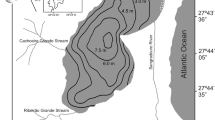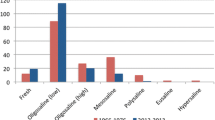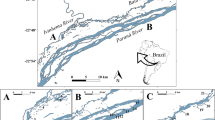Abstract
East-German lowland lakes are highly susceptible to climatic changes, as most lakes are groundwater fed and strongly dependent on the balance of precipitation and evapotranspiration in their catchments. As a significant decrease of precipitation at least during summer is forecasted, a substantial and permanent reduction of lake water levels can be expected. Water-level fluctuations will predominantly affect the eulittoral zone where submerged tree roots form an important habitat type in lowland lakes that will become unavailable for eulittoral invertebrates. Hence, we compared the invertebrate community from eulittoral root habitats with those of infralittoral habitats to test which components of the invertebrate community would be potentially affected by the loss of root habitats, and whether infralittoral habitat types could mitigate these effects. Species richness did not significantly differ between eulittoral roots and the infralittoral habitat types. Community composition of roots significantly differed from that of coarse woody debris, sand and stones but not from reed habitats. Abundances of Coleoptera, Trichoptera and abundances of piercer, predator, shredder and xylophagous species were significantly lower on sand than on roots. Conversely, there were no significant differences in community measures between reed and root habitats except abundances of Coleoptera. Our results suggest that the loss of eulittoral root habitats will cause a significant alteration of the littoral invertebrate community. This could be mitigated if unimpaired reed habitats are available in the infralittoral zone which may serve as a refuge for most species typical for root habitats. Our results need to be verified by direct observations, especially as the extent of future water-level fluctuations is currently not assessable and might be more severe than assumed.

Similar content being viewed by others
References
ATV-DVWK (ed.), 2003. Anthropogene Einflüsse auf Niedrigwasserabflüsse. 1–85.
Black, A. R., G. W. Barlow & A. T. Scholz, 2003. Carbon and nitrogen stable isotope assessment of the Lake Roosevelt aquatic food web. Northwest Science 77: 1–11.
Czachorowski, S., 1989. Vertical distribution of Trichoptera in three Masurian lakes—Results of preliminary studies. Polskie Archiwum Hydrobiologii 36: 351–358.
Czachorowski, S., 1993. Distribution of Trichoptera larvae in vertical profile of lakes. Polskie Archiwum Hydrobiologii 40: 139–163.
Devin, S., C. Piscart, J. N. Beisel & J. C. Moreteau, 2003. Ecological traits of the amphipod invader Dikerogammarus villosus on a mesohabitat scale. Archiv für Hydrobiologie 158: 43–56.
Dufrene, M. & P. Legendre, 1997. Species assemblages and indicator species: The need for a flexible asymmetrical approach. Ecological Monographs 67: 345–366.
Hill, N. M., P. A. Keddy & I. C. Wisheu, 1998. A hydrological model for predicting the effects of dams on the shoreline vegetation of lakes and reservoirs. Environmental Management 22: 723–736.
Hynes, H. B. N., 1961. The effect of water-level fluctuations on littoral fauna. Verhandlungen der Internationalen Vereinigung für Theoretische und Angewandte Limnologie 14: 652–656.
Intergovernmental Panel on Climate Change, 2001. Climate change 2000, Summary for policy makers.
Koskenniemi, E., 1994. Colonization, succession and environmental conditions of the macrozoobenthos in a regulated, polyhumic reservoir, Western Finland. Internationale Revue der Gesamten Hydrobiologie 79: 521–555.
Lenat, D. R. & V. H. Resh, 2001. Taxonomy and stream ecology—The benefits of genus- and species-level identifications. Journal of the North American Benthological Society 20: 287–298.
Ostendorp, W., C. Iseli, M. Krauss, P. Krumscheid-Plankert, J. L. Moret, M. Rollier & F. Schanz, 1995. Lake shore deterioration, reed management and bank restoration in some central-European lakes. Ecological Engineering 5: 51–75.
Palomaki, R. & E. Koskenniemi, 1993. Effects of bottom freezing on macrozoobenthos in the regulated Lake Pyhajarvi. Archiv für Hydrobiologie 128: 73–90.
Palomaki, R., 1994. Response by macrozoobenthos biomass to water-level regulation in some Finnish lake littoral zones. Hydrobiologia 286: 17–26.
PIC (Potsdam Institute for Climate Impact Research), 2003. Studie zur klimatischen Entwicklung im Land Brandenburg bis 2055 und deren Auswirkungen auf den Wasserhaushalt, die Forst- und Landwirtschaft sowie die Ableitung erster Perspektiven. 1–77.
Schmedtje, U. & M. Colling, 1996. Ökologische Typisierung der aquatischen Makrofauna. Informationsberichte des Bayrischen Landesamtes für Wasserwirtschaft 4: 1–548.
Smith, B. D., P. S. Maitland & S. M. Pennock, 1987. A comparative study of water level regimes and littoral benthic communities in Scottish Lochs. Biological Conservation 39: 291–316.
Vadeboncoeur, Y., E. Jeppesen, M. J. Vander Zanden, H. H. Schierup, K. Christoffersen & D. M. Lodge, 2003. From Greenland to green lakes: Cultural eutrophication and the loss of benthic pathways in lakes. Limnology and Oceanography 48: 1408–1418.
Van den Brink, F. W. B., G. van der Velde & A. bij de Vaate, 1993. Ecological aspects, explosive range extension and impact of a mass invader, Corophium curvispinum Sars, 1895 (Crustacea: Amphipoda), in the Lower Rhine (The Netherlands). Oecologia 93: 224–232.
Wilcox, D. A. & J. E. Meeker, 1991. Disturbance effects on aquatic vegetation in regulated and unregulated lakes in northern Minnesota. Canadian Journal of Botany 69: 1542–1551.
Wilcox, D. A. & J. E. Meeker, 1992. Implications for faunal habitat related to altered macrophyte structure in regulated lakes in Northern Minnesota. Wetlands 12: 192–203.
Author information
Authors and Affiliations
Corresponding author
Additional information
Guest editors: K. M. Wantzen, K.-O. Rothhaupt, M. Mörtl, M. Cantonati, L. G.-Tóth & P. Fischer
Ecological Effects of Water-Level Fluctuations in Lakes
Rights and permissions
About this article
Cite this article
Brauns, M., Garcia, XF. & Pusch, M.T. Potential effects of water-level fluctuations on littoral invertebrates in lowland lakes. Hydrobiologia 613, 5–12 (2008). https://doi.org/10.1007/s10750-008-9467-0
Published:
Issue Date:
DOI: https://doi.org/10.1007/s10750-008-9467-0




